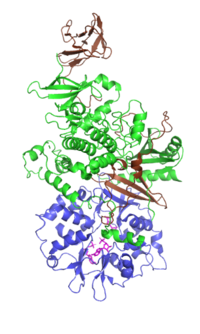
Imatinib suppresses activation of hepatic stellate cells by targeting STAT3/IL‐6 pathway through miR‐124
Sign Up to like & getrecommendations! Published in 2023 at "Cell Biology International"
DOI: 10.1002/cbin.11992
Abstract: The activation of hepatic stellate cells is the primary function of facilitating liver fibrosis. Interfering with the coordinators of different signaling pathways in activated hepatic stellate cells (aHSCs) could be a potential approach in ameliorating… read more here.
Keywords: imatinib; liver fibrosis; mir 124; stat3 ... See more keywords

Isolation of a unique hepatic stellate cell population expressing integrin α8 from embryonic mouse livers
Sign Up to like & getrecommendations! Published in 2018 at "Developmental Dynamics"
DOI: 10.1002/dvdy.24634
Abstract: Background: Hepatic stellate cells (HSCs) play an important role in liver fibrogenesis. However, little is known about their phenotype and role in liver development. The aim of this study is to identify specific markers for… read more here.
Keywords: liver; perivascular mesenchymal; itga8; mesenchymal cells ... See more keywords

The adenosine monophosphate–activated protein kinase—vacuolar adenosine triphosphatase–pH axis: A key regulator of the profibrogenic phenotype of human hepatic stellate cells
Sign Up to like & getrecommendations! Published in 2018 at "Hepatology"
DOI: 10.1002/hep.30029
Abstract: Liver fibrosis and cirrhosis are characterized by activation of hepatic stellate cells (HSCs), which is associated with higher intracellular pH (pHi). The vacuolar H+ adenosine‐triphosphatase (v‐ATPase) multisubunit complex is a key regulator of pHi homeostasis.… read more here.
Keywords: atpase; ampk; activation; adenosine ... See more keywords

A Deactivation Factor of Fibrogenic Hepatic Stellate Cells Induces Regression of Liver Fibrosis in Mice
Sign Up to like & getrecommendations! Published in 2019 at "Hepatology"
DOI: 10.1002/hep.30965
Abstract: Hepatic stellate cells (HSCs), a key player in the progression of liver fibrosis, are activated by various inflammatory stimuli and converted to myofibroblast‐like cells with excessive collagen production. Despite many attempts to suppress activation of… read more here.
Keywords: fibrosis; liver fibrosis; deactivation; hepatic stellate ... See more keywords

Emergence of highly profibrotic and proinflammatory Lrat+ Fbln2+ hepatic stellate cell subpopulation in alcoholic hepatitis.
Sign Up to like & getrecommendations! Published in 2022 at "Hepatology"
DOI: 10.1002/hep.32793
Abstract: BACKGROUND AND AIMS Relative roles of hepatic stellate cells (HSCs) and portal fibroblasts (PFs) in alcoholic hepatitis (AH) are unknown. We aimed to identify subpopulations of Col1a1- expressing cells in a mouse AH model by… read more here.
Keywords: fbln2 cells; lrat fbln2; hepatic stellate; lrat ... See more keywords

Therapeutic modulators of hepatic stellate cells for hepatocellular carcinoma
Sign Up to like & getrecommendations! Published in 2020 at "International Journal of Cancer"
DOI: 10.1002/ijc.32899
Abstract: Hepatocellular carcinoma (HCC) is the most common type of primary tumor in the liver and is a leading cause of cancer‐related death worldwide. Activated hepatic stellate cells (HSCs) are key components of the HCC microenvironment… read more here.
Keywords: hepatocellular carcinoma; hscs; activated hscs; hepatic stellate ... See more keywords

Diallyl trisulfide plays an antifibrotic role by inhibiting the expression of Bcl‐2 in hepatic stellate cells
Sign Up to like & getrecommendations! Published in 2022 at "Journal of Biochemical and Molecular Toxicology"
DOI: 10.1002/jbt.23097
Abstract: Hepatic fibrosis is an important early stage in the evolution of liver cirrhosis, and specific medicine and therapeutic measures are unavailable to date. Hepatic stellate cells (HSCs) are the main cells involved in the formation… read more here.
Keywords: stellate cells; hepatic fibrosis; hepatic stellate; fibrosis ... See more keywords

Myrrhone inhibits the progression of hepatic fibrosis by regulating the abnormal activation of hepatic stellate cells
Sign Up to like & getrecommendations! Published in 2022 at "Journal of Biochemical and Molecular Toxicology"
DOI: 10.1002/jbt.23177
Abstract: We focus on exploring the antihepatic fibrosis effect of Myrrhone (Myr), a compound extracted from myrrh, and its effective target. Mouse hepatic stellate cells (HSCs) were cultured in vitro and activated by transforming growth factor‐β… read more here.
Keywords: stellate cells; hepatic fibrosis; myr; hepatic stellate ... See more keywords

Arginase 1 expression is increased during hepatic stellate cell activation and facilitates collagen synthesis.
Sign Up to like & getrecommendations! Published in 2023 at "Journal of cellular biochemistry"
DOI: 10.1002/jcb.30403
Abstract: Activation of hepatic stellate cells (HSC) is a key event in the initiation of liver fibrosis. Activated HSCs proliferate and secrete excessive amounts of extracellular matrix (ECM), disturbing liver architecture and function, leading to fibrosis… read more here.
Keywords: arginase; expression increased; hsc activation; expression ... See more keywords

Fasting inhibits hepatic stellate cells activation and potentiates anti‐cancer activity of Sorafenib in hepatocellular cancer cells
Sign Up to like & getrecommendations! Published in 2018 at "Journal of Cellular Physiology"
DOI: 10.1002/jcp.25987
Abstract: Hepatocellular carcinoma (HCC) has a poor outcome. Most HCCs develop in the context of liver fibrosis and cirrhosis caused by chronic inflammation. Short‐term fasting approaches enhance the activity of chemotherapy in preclinical cancer models, other… read more here.
Keywords: hcc; activity; activation; cancer ... See more keywords

Apoptotic and antihepatofibrotic effect of honokiol via activation of GSK3β and suppression of Wnt/β‐catenin pathway in hepatic stellate cells
Sign Up to like & getrecommendations! Published in 2020 at "Phytotherapy Research"
DOI: 10.1002/ptr.6824
Abstract: Though honokiol, derived from the Magnolia tree, was known to suppress renal fibrosis, pulmonary fibrosis, non‐alcoholic steatoheptitis, inflammation and cancers, the underlying antifibrotic mechanisms of honokiol are not fully understood in hepatic stellate cells until… read more here.
Keywords: catenin; hepatic stellate; honokiol; gsk3 ... See more keywords